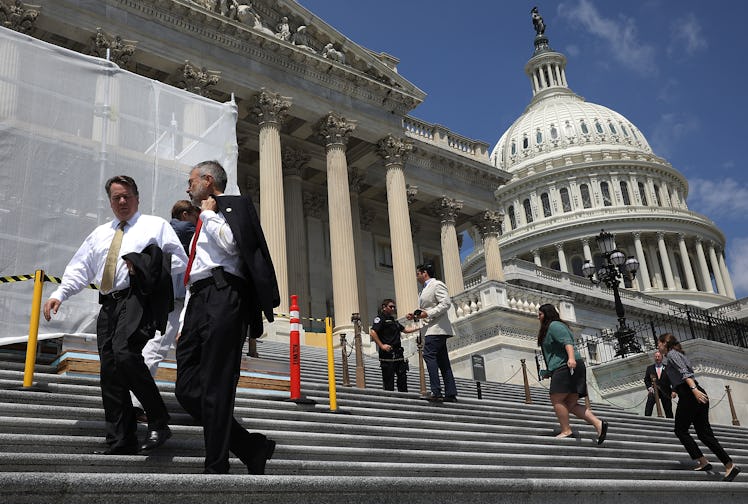
It Was A Good Election Night For The Democrats In The House, Thanks To These Key Wins
The results are in, and you might be asking yourself, "Did Democrats flip the House after the midterm election on Nov. 6?" Rest assured that they did in fact flip it. For the first time since the House was last blue in 2008, the Republican party lost control of the House of Representatives, with the predicted "Blue Wave" showing up after a contentious couple months of campaigning. While early predictions for the midterms House race found that Democrats were more likely than not to gain control (they needed to flip just 23 seats, after all), the race was a surprise with 26 previously red districts in the country flipping Democrat.
Of the 435 seats in the House, the Democrats added to their current 193 seats with 26 new additions after competitive races in 60 different districts. Non-biased polling sites like Five Thirty Eight previously estimated that there was a 5 in 6 chance (or 81.9 percent) that the Democrats would take control of the House of Representatives as they estimated to varying degrees the number of "leaning seats" and complete toss-ups that were up for change. Early predictions showed that Republicans were at a disadvantage. According to the Cook Political Report, it was estimated that there were 45 current Republican districts that could go either way while there were only three currently Democratic toss-ups.
In addition to early poll predictions, President Trump's historically-low approval ratings (Five Thirty Eight found that 53 percent of Americans disapproved of the POTUS in the days leading up to the election) seemed to hint that the Democratic party could be due for a blue takeover. Polling site Gallup found that a president's approval rating dipping below 50 percent has historically correlated with his party losing an average of 36 seats during the midterm election.
Earlier forecasts ended up playing out on Nov. 6. In keeping with predictions from The Washington Post, New Jersey’s 2nd District, Florida’s 27th, Arizona’s 2nd, California’s 49th, New Jersey’s 11th, and Virginia’s 10th were among the expected districts that flipped to blue. In addition, of the 26 seats that the Democrats won, surprises included Arizona's 2nd, Colorado's 6th, Florida's 26th, Texas's 7th, and more. For a full list of House seats that the Democrats flipped, click here.
So, what does this mean? While the Senate is still Republican, a Democratic-controlled House of Representatives means that the party will likely be working to strengthen historically left-leaning issues like lowering health care costs and potentially getting somewhere with gun control regulations, according to the The New York Times.
It's also likely that a Democratic midterm victory would bring about more investigations into the Trump administration, including the long-running inquiry by special counsel Robert Mueller to determine whether the president and his campaign staff collaborated with Russia to influence the results of the 2016 presidential race. There's also a chance that the Democrats could stick with their October promise to open an investigation into alleged misconduct and perjury against embattled Supreme Court Justice Brett Kavanaugh, who was recently confirmed after a contentious hearings process after multiple allegations of sexual assault, which he denied. Elite Daily reached out to Kavanaugh's team for comment but did not hear back by the time of publication.
For now, it remains to be seen how the Democratic-leaning House of Representatives will contest President Trump and the Republican-controlled Senate's conservative agenda leading into the next two years and set the stage for the 2020 Presidential Election.